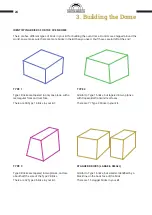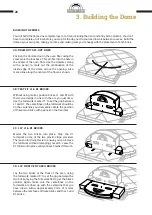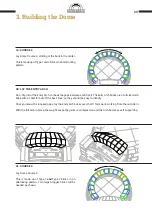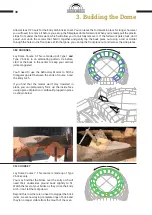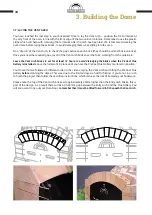
23
3. Building the Dome
To lay the fire bricks for the dome and opening of the oven, you’ll use our two-part Refractory Mortar. Remember,
fire bricks are very porous, so if you apply wet mortar to a dry fire brick this mortar will dry out immediately, and
will not bond well to the brick. To overcome this, soak the bricks that you’re about to lay in water for at least
10 minutes before you lay them. Take the bricks out of the water shortly before you need them, then when you
grab a brick to lay, if it’s soaking wet dry it with a cloth to remove the excess surface moisture.
The same issue applies to bricks that you laid earlier, maybe days or weeks before, which may have dried out.
Wet down these bricks before you lay onto them, using a soaking wet sponge or a light spray with a hose.
The Refractory Mortar that you’ll use from this point onwards is a two-part mixture, included in the kit.
REFRACTORY MORTAR MIXTURE
•
3 PARTS ‘REFRACTORY MORTAR PART A’
•
1 PART ‘REFRACTORY MORTAR PART B’
These measurements are by volume (i.e. 3 cups of Part A to 1 cup of Part B). Mix well while dry, before adding
enough water to make a smooth, thick mixture, like porridge. Take a trowel full of the mortar and hold it upside
down, it should stick to the trowel. The pot life of this mix is around 30 minutes depending on the ambient
temperature. Only mix what you can use in that time! Start with small batches until you get the hang of it.
This mix is ‘thixotropic’, meaning it will become more fluid (runny) when it is stirred, and very thick when it
remains still. If your mortar becomes stiff in the bucket, stir it again with your trowel or mixing drill and it will
become workable.
Do not add more water. This would greatly reduce the final strength of the cured mortar.
After use, close the tops of these bags to stop the contents deteriorating and store them in a cool, dry place.
TIPS FOR LAYING FIRE BRICKS
Be careful not to ‘bump’ any of your brickwork as you build. This can break the bond between the mortar and
the affected bricks. This is a big project, so take your time and be careful. Give yourself good access to your
slab, you may want to make a step or use trestles to get better access once you reach the higher courses.
The mortar gap on the inside face of the oven should be kept to a minimum. Aim for brick-on-brick joints for the
inside face of the dome. The mortar gaps between each brick in your vertical columns that make up the entry
and vent arches should be a approximately 3mm thick. There are markings on the formwork to show you where
each joint should be and how thick to make them. Make sure you completely fill every gap in your brickwork
with mortar, from the inside to the outside face.
A rubber or ‘deadblow’ mallet is highly recommended to help you lay the fire bricks for the oven dome. A light
tap before releasing the brick from the trammel helps to set the brick in place, and the mallet will be very useful
for getting your Entry Arch and Vent Arch column brick joints thin and even.
Building the Dome
Содержание D95
Страница 1: ...D95 Brick Oven D95 PRECUT BRICK OVEN KIT Instruction Booklet ...
Страница 44: ...44 Examples ...
Страница 45: ...45 Examples ...
















